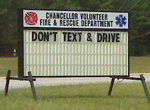Yesterday, U.S. Department of Transportation Secretary Ray LaHood announced voluntary guidelines (pdf) to "encourage automobile manufacturers to limit the distraction risk for in-vehicle electronic devices." The guidelines cover communication, entertainment, information gathering and navigation devices that are not necessary for the safe operations of a vehicle by the driver.
With electronics "driving"(pdf) new automobile features and competitive positioning, it will be interesting to see how closely the automotive manufacturers follow these guidelines. Last year, for example, Volkswagen said it viewed its vehicles as "rolling computers" and that connecting consumer electronics to its vehicles' systems was a high-priority.
The Department of Transportation press release states that the guidelines will be rolled out in three phases. Phase I suggests "criteria that manufacturers can use to ensure the systems or devices they provide in their vehicles are less likely to distract the driver with tasks not directly relevant to safely operating the vehicle, or cause undue distraction by engaging the driver's eyes or hands for more than a very limited duration while driving."
The Phase I criteria focus on electronics built into the car and address human-electronic system interface issues (e.g., limit a device's operation to one hand only). Phase I also recommends essentially disabling "in-vehicle electronic devices while driving, unless the devices are intended for use by passengers and cannot reasonably be accessed or seen by the driver, or unless the vehicle is stopped and the transmission shift lever is in park."
The basic idea is to keep the driver's hands on the wheel and eyes on the road. US DOT recommends disabling:
- Visual-manual text messaging;
- Visual-manual internet browsing;
- Visual-manual social media browsing;
- Visual-manual navigation system destination entry by address;
- Visual-manual 10-digit phone dialing;
- Displaying to the driver more than 30 characters of text unrelated to the driving task.
Phase II guidelines are likely to focus on "devices or systems that are not built into the vehicle but are brought into the vehicle and used while driving, including aftermarket and portable personal electronic devices such as navigation systems, smart phones, electronic tablets and pads, and other mobile communications devices."
Phase III guidelines are likely to focus on "voice-activated controls to further minimize distraction in factory-installed, aftermarket, and portable devices."
The Alliance of Automobile Manufacturers reacted cautiously to the announcement, the Washington Post reported. It is generally supportive of reducing the opportunity for distracted driving, but wants what it calls the "two-second rule" to be the guiding principle. In the words of a Alliance spokesperson:
"Basically, any task behind the wheel that takes more than two seconds to complete or can’t be completed in a couple of brief chunks would be locked out or would be prohibited."
Currently, there are no penalties attached for not following the proposed DOT guidelines, which has disappointed the National Safety Council, the New York Times reported. The NSC wants tougher, mandatory requirements not mere guidelines imposed on automotive manufacturers.
The DOT press release noted that President Obama's FY 2013 budget request includes some $330 million over the next six years to fund distracted driving programs. The programs are aimed to increase awareness of the dangers of distracted driving and encourage states to pass laws to curb it. So expect a lot more advertisements about the dangers of distracted driving for the next several years.
The guidelines, which were published in the Federal Register yesterday, have a 60-day public comment period. If the reaction of readers at the Washington Post to the news of the guidelines is any indication, DOT should expect a lot of not-so-supportive comments.
Any comments from Risk Factor readers on the guidelines? For instance, should they be mandatory as the National Safety Council is advocating?
Robert N. Charette is a Contributing Editor to IEEE Spectrum and an acknowledged international authority on information technology and systems risk management. A self-described “risk ecologist,” he is interested in the intersections of business, political, technological, and societal risks. Charette is an award-winning author of multiple books and numerous articles on the subjects of risk management, project and program management, innovation, and entrepreneurship. A Life Senior Member of the IEEE, Charette was a recipient of the IEEE Computer Society’s Golden Core Award in 2008.



